Discussion
審査講評(7)
Comments on Jurors’ Special Prizes winners
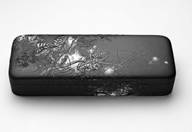
Blackberries’ Dream
H5.5×W29.5×D11
2013

MANI
H36×W28×D28
2014
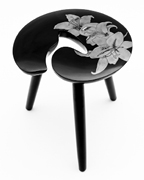
Time Capsule of Life
H43×W35.5×D38
2013
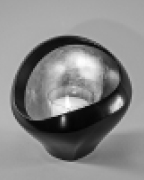
乾漆燭台—月明り
Candle Holder - Moonlight
H21×W23×D23
2013
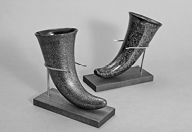
リュトン型コップ
Ryuton Cup
各 H16.5×W14×D9
2014
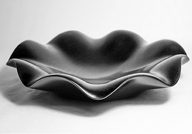
蓮の葉皿
Lotus Leaf Plate
H4×W30×D30
2014
Ohnishi ───── I would like Mr Ekuan to make comment on the Kenji Ekuan Prize winner “Blackberries’ Dream”.
Ekuan ───── The Kenji Ekuan Prize winner “Blackberries’ Dream” is not a large-sized work, 29 cm wide, 11 cm deep and 5.5 cm height. It looks like a small letter box or a big pencil case. The artist has used various techniques to achieve this look. He made layers of Urushi and created fireflies’ lights to complete this beautiful work. I have purchased some works from this exhibition at this International Urushi Exhibition for some years. I would personally like to purchase this work and treasure this. I will do this in honor of his participation in the Russian exhibition and to remember his work from Russia.
I hope this prize winning will help more Russian artists to participate in the Urushi activities and exhibitions. This work is a different interpretation of traditional Urushi ware, however, through its beauty in craftsmanship we can see the Urushi spirit. I hope you will visit the Exhibition and enjoy holding the work by hand.
Ohnishi ─────Next I would like to make comment on the Nagatoshi Ohnishi Prize winner “MANI”. When you visit Tibet, you will see the large MANI hanging from the ceiling being turned, or read, by people. Inside MANI are the Shingon Tantric Buddhism scriptures. When you turn the MANI once, you are considered to have read the whole scriptures.
Tibet has been called “The final fort of the globe”, despite that China tries to market Tibet as a tourists’ destination. Many people worry about China destroying Tibetan civilization and cultures. The Dali Lama ran away from Tibet to India and has instructed his followers to also do this in many ways. The important thing for their belief is MANI. MANI is created in various sizes, from small to carry to very big ones.
I have visited Tibet to study Urushi for many years. During this time, I have learned that the Tibetan people like Urushi ware very much and use it every day.
The artist of the Nagatoshi Ohnishi Prize, INAMI Jun is from Wajima. He has visited Tibet to study MANI as well. This work operates in the same way as the wood-turning MANI from Tibet. You can turn the work by hand. It is 30 cm diameter and 25 cm height. His craftsmanship is well done and a delight to behold
I have mentioned that Urushi changes while the Urushi ware is living with the human beings. The users will discover a new beauty within each piece the longer it is used and handled. Through the annals of time, with decades of repetitive use, these pieces will evolve into a new thing to admire and respect as a new art form. This might not be a modern way of thinking, but I believe we live our lives in the same time and space in regards to the flow of history. I feel a connection to the oriental design in this work and I would like to keep this work at my side.
Next Prof Komatsu will talk about the Ryoichi Komatsu Prize winner.
Komatsu ───── “Time Capsule of Life” by KIM Sunhwa from the United States reflects the human body movement and human inner-body movement when they sit on the stool. The striking lily patterns are well-fit into the stool. It is both a modern and novel work.
Ohnishi ─────Next I would like to tell you briefly about the Kwon Sang-Oh Prize winner, “Candle Holder – Moonlight” by KUSUDA Naoko. This is Kanshitsu (dry Urushi) work with that is 20 cm diameter and 15 cm height. Inside the work is displayed a corresponding gold leaf and platinum leaf and in the center is a lit-candle. The candle light is reflected to the gold and platinum leaf which show the beauty of these two materials. The fluctuation of the flame light expands and makes the reflection more effective. KUSUDA Naoko is from Nara. She has exhibited a candle holder each occasion of the exhibition. Prof Kwon is fascinated with her work and has encouraged me to remark on the curved surfaces that give way to a fantastic space inside the piece. Indeed, these are worthy of mentioning here.
Next I would like Mr Mae to make comment on the Fumio Mae Prize winner “Ryuton Cup”.
Mae ───── When Buddhism was introduced to Japan, the Buddhist priests held the responsibility of creating Buddhist images. Instead of the heavy bronze images, light and durable Kanshitsu Buddhist images were created. The characteristics of the work include a light, durable, and gentle texture of the Kawari-nuri that has a stone-grain finish. I enjoy viewing the beautiful surface treatment such as silver coating, and feeling the texture of the shading and grinding. The title says “Cup” but the work can be used in another way.
I usually think it is important to use Urushi ware, even though sometimes it is not used. This work is a delightful piece because they can be used and at the same time they can be viewed as a decoration.
Ohnishi ───── Thank you for your comment. Lastly, I would like Mr Yamamura to make comment on the Shinichi Yamamura Prize winner.
Yamamura ───── I selected “Lotus Leaf Plate”. The Lotus flowers have been used for entertaining guests. This work, a plate, displays a motif of a lotus leaf. The artist carves it out by hand using small planes and chisels, which is a painstaking initial process. The soft texture of the material, a Japanese white-barked magnolia, and lightness and simplicity to hold are soft to the touch for the holder. As a plate for entertaining your guests, this work is excellent. On the surface of the base material his precise Urushi coating is applied. I am attracted by the work because it is finished not by wood-turning lathes or routers, but by hand, which is rare in these days. Mysterious high lights and waves bring variations to the work. When you arrange food or confectionaries on the plate, your arrangement will be outstandingly enhanced.
Ohnishi ───── Thank you all for your comment.

